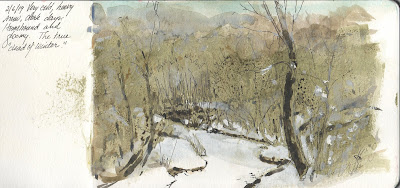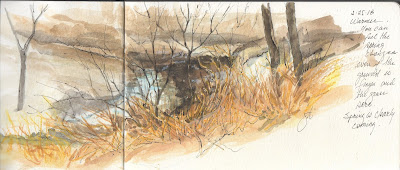The idea that art can cause a sudden jolt, an emotional tremor, is relatively new. In the last thirty years or so, various provocative and sometimes disgusting images and other items have been included in the classification of "shock art." A good example is the photography of
Robert Mapplethorpe whose 1989 touring show, Robert Mapplethorpe: The Perfect Moment, included various homoerotic photos that were deemed obscene by some authorities and were definitely shocking to many. The resultant firestorm of arrests and lawsuits were perhaps the beginning of shock art.
 |
| Hieronymus Bosch, "Garden of Earthly Delights," triptych, ~1500 |
But shock art existed long before Mapplethorpe. Art that is intended to provoke has been seen in most centuries. Painters like Hieronymous Bosch (15-16th century) produced horrifying paintings depicting the terrors of hell, paintings that emphasized the punishments that awaited the sinful, paintings intended to shock. Others in that era worked in a similarly religious vein, if only because the church itself, and the occasional royal, were virtually the only market for art. My own favorite by "El Bosco," as he is known in Spanish, is The Garden of Earthly Delights, a triptych showing the Garden of Eden in the left panel and Hell in the right. It's center panel is a matter of conjecture but certainly displays all kinds of human desire and dreams. The painting is in the Prado Museum in Madrid.
 |
| Diego Velazquez, "Pope Innocent X," 1650 |
Although he's not thought of as a shock artist, Diego Velazquez, who was active in the early 17th century, painted at least one shocking piece. His portrait of Pope Innocent X, who was a member of the Italian Pamphilij family, is pitiless in its exploration of the pope's face. Here is a pitiless, unattractive man with a riveting gaze and a protruding jaw. He could be a military commander, perhaps, with that cruel expression, but surely not the humble, compassionate, and understanding foundation of the Church. When he saw the painting, Innocent is said to have demanded that it be taken away--it was too real. Was it shocking to the Christian world to find that the Pope could look like a cruel emperor? Maybe. The portrait is in the
collection of the Doria-Pampilij Palace where is has been for nearly 400 years. You can see the pope and a number of other masterpieces in the Doria-Pamphilj, and not-to-be-missed museum stop in Rome.
 |
| Francisco Goya, "Saturn Devouring His Son," 1819-1823 |
You might argue that shocking art (like the portrait of Innocent) isn't necessarily shock art, that the shock or surprise is an unintentional side effect. Shock art is intentionally shocking, perhaps. If we use intention as a qualifier, then perhaps
Francisco Goya is one of the more prominent practitioners of shock art. Although Goya was for most of his career a fairly conventional if emotional painter, in his
Black Paintings certainly are shocking, particularly for that time. These fourteen paintings were actually done by Goya directly on the wall of his home and were later transferred to frames and are on display in the Prado. The most shocking is
Saturn Devouring His Son, based on the Greek myth that said Saturn would be replaced by one of his children; accordingly he devoured them. This was one of the paintings in Goya's dining room, but one suspects it would put many off their food, given its graphic depiction of cannibalism.
 |
| Alfred Steiglitz "Photo of 'Fountain,' by RMutt" |
Art with the capacity to intentionally evoke strong emotion became more common by the late 19th century and into the whole of the 20th. Consider that shock art might be an intentional thumb in the eye of the "art world." That was part of the point of "
Fountain," the "sculpture" (actually and upturned urinal) submitted to a New York art exhibition by Marcel Duchamp under an assumed name, in 1917. Submission of a urinal caused an enormous debate, the piece was suppressed and eventually lost. But it continues to turn up in art history because it is viewed as one of the signal moments when art took different turn. "Readymades' as or found items became important departure points for modern and contemporary sculpture. Without Duchamp's urinal Picasso would never have produced his bull from a bicycle.
Art in these cacophonous days must shout for attention. Unlike a century ago when mass communication was slow, limited to the arts, print, film and embryonic radio, the competition for
 |
| Piero Manzon, signed, numbered can of "Merde d'Artiste," 1961 |
attention was minimal and content was less emotionally arresting. In the 20th century, outrageous became the norm as prices spiraled higher and for some anything produced by an artist could have value, even feces. In 1961, in an enormous joke that shocked the art world he released cans labelled
Merde d'Artiste which putatively contained fecal material. He seemed to be commenting on the art world in general as well as laughing at people who would (and did) buy his art. As to what is really inside, no one has opened a can.
In 1987, for example, the Andres Serrano photo
Piss Christ generated a storm of criticism as blasphemous since it showed a crucifix submerged in a yellow liquid. Mind you, the only evidence for urine being that liquid is the title and the color in the photograph. Serrano himself claimed, disingenuously, that he was shocked himself that people found it blasphemous. He had been doing other photos of classical sculptures submerged in all sorts of body fluids, and swore this piece was intended to memorialize the horror of death. Perhaps the shock was an over reaction, perhaps not.
 |
| Lucien Freud "Benefit Supervisor Sleeping (Sue Tilley)," 1995 |
In the 20th century too, certain painters became shocking. For example, Lucien Freud began producing nudes of pointedly unattractive people, using them to explore the human figure and flesh as landscapes. Those portraits and nudes remain shocking and even repugnant to many. One of his most famous, Benefit Supervisor Sleeping, shows a seriously obese woman reclining on a sofa in his studio. The painting is controversial--fans declare it a masterpiece while others find it ugly and not worthy of the attention. Certainly it is an imposing painting at 59x86 inches.
There have been other examples in the last half century or so, but those can wait for another post.







































